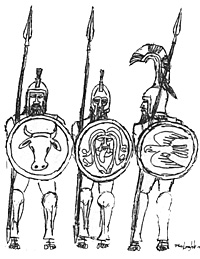 This started out as a ‘Forum’ letter but I guess it could become a mini article [so right John]. I have enjoyed the last few Lone Warriors, plenty of variety to get one thinking about new rules.
This started out as a ‘Forum’ letter but I guess it could become a mini article [so right John]. I have enjoyed the last few Lone Warriors, plenty of variety to get one thinking about new rules.
I also subscribe to ‘Slingshot’, journal of the Society of Ancients. A recent edition highlights the usual feuds between WRG and rule sets advocates. I find it quite interesting that wargamers invest so much time to prove one set is superior to another and that print space in magazines should be fought over.
One of the reasons I subscribe to the SWA is because of the variety of rules on offer and the free exchange of ideas. Long may it continue.
One of the more dramatic articles I have encountered is George Heath’s, ‘Genesis’ of Lone Warrior 141, page 43, in which there is a disarmingly simple set of rules George has created a gem for campaigns.
My current wargaming is fitted in between lots of other commitments so I have used George’s article as a brief experiment. To start with I just used the conquest idea with destinies where certain hexes must set out to conquer another distant hex.
Far from brief I found this compulsive and have played the experimental land through to a conclusion. Twelve or so kingdoms resulted from the initial round of individual hexes attacking their neighbours in pursuit of their destiny. The 12 have now been reduced to one dominant kingdom and three weak ones.
The dominant kingdom started out as a peripheral one. Other bigger kingdoms grew and were in turn destroyed. The dominant kingdom had two very long distant destinies plus it was never a target for other kingdoms destinies.
George’s article promised lots of battles and is certainly proving the case. I fought a few using figures and DBA rules, but the rest needed a speedy conclusion. I used a method similar to the old ‘KingMaker’ advanced rule between two armies consisting of three parts: The Left Flank (Van); Centre (Main Battle); Right Flank (Rear). Each part was represented by a playing card randomly drawn. Arrayed opposite each other the highest card would win each of the three encounters. Invariably a result occurred, although there were sufficient drawn battles.
I subsequently added a further refinement of a reserve. The reserve comprised an extra card for every 5 hexes owned. Also a ‘Brilliant Leader’ (5 or 6 on a D6) had a personal reserve of one card. Brilliant Leaders could also move up to two cards at anytime to achieve best effect. Average Leaders (3 or 4 on D6) could move 1 card. Brilliant Generals always played last.
The resulting battles were fast, furious and variable in outcome. Sometimes small kingdoms with Brilliant Leaders won decisive battles setting them on their way to conquer larger neighbours.
Also during this experiment – which was now assuming a campaign of some proportion – I switched from DBA to ‘Strategos’ for the occasional figure battles. Phil Sabin’s rules adopt an influence approach to movement and combat – exact location of each unit is not material. Some will argue the battle looks more like chess and some purists will be appalled that the tape measure is sidelined. I am still a novice – only four battles to date but I quite like the concept. I will not be able to resist altering some of the rules. But warned, Phil has used a text orientated approach and it takes a while to remember where key phases re. I suggest you create your own quick reference sheet for these rules. What do other readers think?
As for George’s article I will definitely incorporate the ‘destiny’ idea into my campaign rules and the experimental campaign territory will be slotted into my world map somewhere along with the vague histories of the many battles. I found George’s ideas provided just the right level of characterisation.
Some extra thoughts…
A further refinement. When invading armies attacked a hex the first defence was always local. These militia armies would lose any part of their battle where their red card was attacked by a black suit, irrespective of the card value.
Further thoughts on Campaign Rules:
As kingdoms grew I permitted extra armies. A kingdom of 20 hexes or more could have two armies. An army could only attack on a destiny. If there were two destinies unfulfilled, both armies could attack. Any unused armies could defend their kingdom against attack. Despite these advantages the small country with a single destiny often made headway against bigger countries.
One disadvantage of the destiny system was that I did not impose significant terrain obstacles. This tended to create linear kingdoms. I will probably overcome this with better terrain definition and the use of influential hexes: Taking control of one of these would mean so many adjacent hexes controlled as well.
Thanks George for an excellent article and ideas. And thanks Kenn for sterling work in getting Lone Warrior issued every time. [Don’t forget Graham ‘The Distribution’ and David ‘The Labels’, who work very hard on behalf of the members of the SWA. Thank you John, for sharing this with the rest of us. Kenn].
Back to Table of Contents -- Lone Warrior # 148
Back to Lone Warrior List of Issues
Back to MagWeb Magazine List
© Copyright 2004 by Solo Wargamers Association.
This article appears in MagWeb.com (Magazine Web) on the Internet World Wide Web.
Other articles from military history and related magazines are available at http://www.magweb.com
